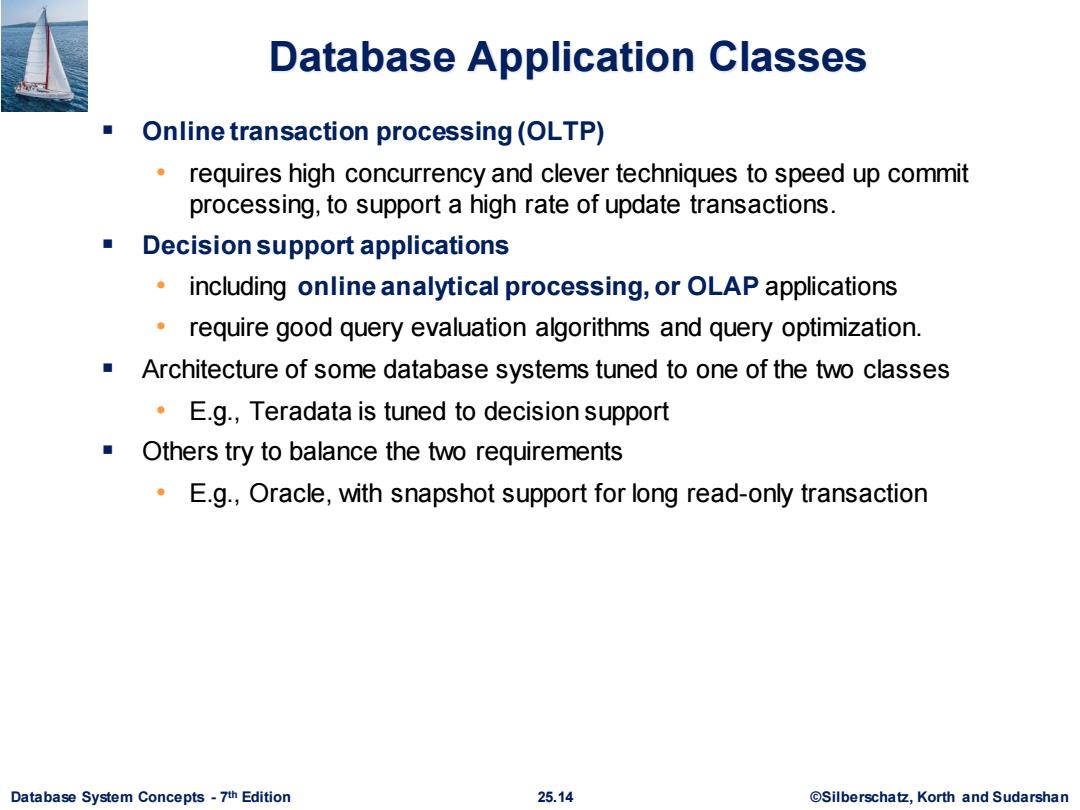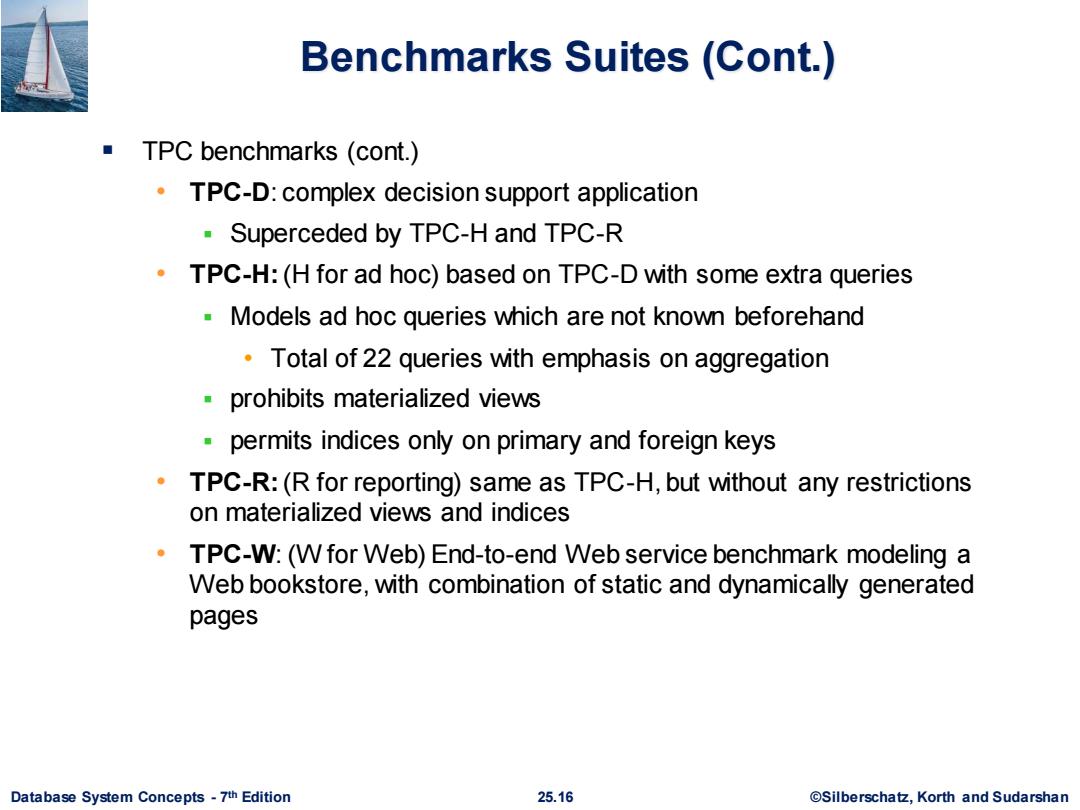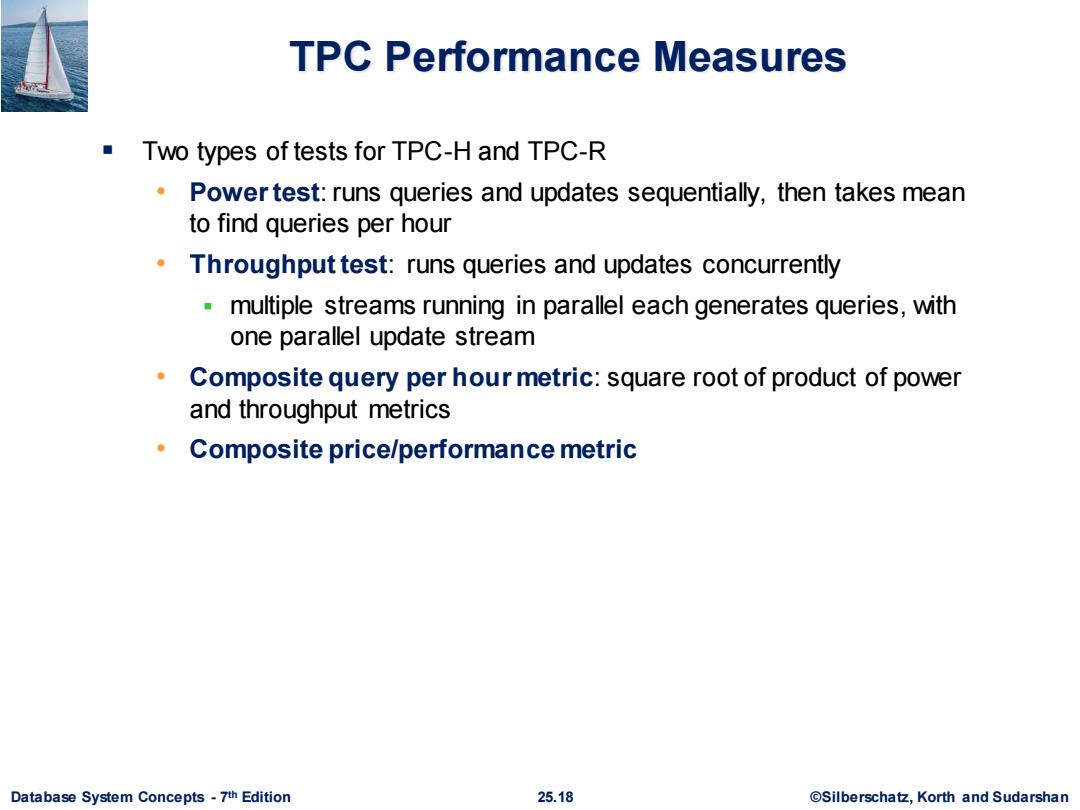
Performance Simulation Performance simulation using queuing model useful to predict bottlenecks as well as the effects of tuning changes,even without access to real system Queuing model as we saw earlier Models activities that go on in parallel Simulation model is quite detailed,but usually omits some low level details Model service time,but disregard details of service E.g.,approximate disk read time by using an average disk read time Experiments can be run on model,and provide an estimate of measures such as average throughput/response time Parameters can be tuned in model and then replicated in real system E.g.,number of disks,memory,algorithms,etc. Database System Concepts-7th Edition 25.11 ©Silberscha乜,Korth and Sudarshan
Database System Concepts - 7 25.11 ©Silberschatz, Korth and Sudarshan th Edition Performance Simulation ▪ Performance simulation using queuing model useful to predict bottlenecks as well as the effects of tuning changes, even without access to real system ▪ Queuing model as we saw earlier • Models activities that go on in parallel ▪ Simulation model is quite detailed, but usually omits some low level details • Model service time, but disregard details of service • E.g., approximate disk read time by using an average disk read time ▪ Experiments can be run on model, and provide an estimate of measures such as average throughput/response time ▪ Parameters can be tuned in model and then replicated in real system • E.g., number of disks, memory, algorithms, etc

Database Application Classes Online transaction processing(OLTP) requires high concurrency and clever techniques to speed up commit processing,to support a high rate of update transactions. Decision support applications including online analytical processing,or OLAP applications require good query evaluation algorithms and query optimization. Architecture of some database systems tuned to one of the two classes E.g.,Teradata is tuned to decision support Others try to balance the two requirements E.g.,Oracle,with snapshot support for long read-only transaction Database System Concepts-7th Edition 25.14 ©Silberscha乜,Korth and Sudarshan
Database System Concepts - 7 25.14 ©Silberschatz, Korth and Sudarshan th Edition Database Application Classes ▪ Online transaction processing (OLTP) • requires high concurrency and clever techniques to speed up commit processing, to support a high rate of update transactions. ▪ Decision support applications • including online analytical processing, or OLAP applications • require good query evaluation algorithms and query optimization. ▪ Architecture of some database systems tuned to one of the two classes • E.g., Teradata is tuned to decision support ▪ Others try to balance the two requirements • E.g., Oracle, with snapshot support for long read-only transaction

Benchmarks Suites (Cont.) TPC benchmarks (cont.) TPC-D:complex decision support application Superceded by TPC-H and TPC-R TPC-H:(H for ad hoc)based on TPC-D with some extra queries Models ad hoc queries which are not known beforehand Total of 22 queries with emphasis on aggregation prohibits materialized views permits indices only on primary and foreign keys TPC-R:(R for reporting)same as TPC-H,but without any restrictions on materialized views and indices TPC-W:(W for Web)End-to-end Web service benchmark modeling a Web bookstore,with combination of static and dynamically generated pages Database System Concepts-7th Edition 25.16 ©Silberscha乜,Korth and Sudarshan
Database System Concepts - 7 25.16 ©Silberschatz, Korth and Sudarshan th Edition Benchmarks Suites (Cont.) ▪ TPC benchmarks (cont.) • TPC-D: complex decision support application ▪ Superceded by TPC-H and TPC-R • TPC-H:(H for ad hoc) based on TPC-D with some extra queries ▪ Models ad hoc queries which are not known beforehand • Total of 22 queries with emphasis on aggregation ▪ prohibits materialized views ▪ permits indices only on primary and foreign keys • TPC-R:(R for reporting) same as TPC-H, but without any restrictions on materialized views and indices • TPC-W: (W for Web) End-to-end Web service benchmark modeling a Web bookstore, with combination of static and dynamically generated pages

TPC Performance Measures Two types of tests for TPC-H and TPC-R Power test:runs queries and updates sequentially,then takes mean to find queries per hour Throughput test:runs queries and updates concurrently multiple streams running in parallel each generates queries,with one parallel update stream Composite query per hour metric:square root of product of power and throughput metrics Composite price/performance metric Database System Concepts-7th Edition 25.18 ©Silberscha乜,Korth and Sudarshan
Database System Concepts - 7 25.18 ©Silberschatz, Korth and Sudarshan th Edition TPC Performance Measures ▪ Two types of tests for TPC-H and TPC-R • Power test: runs queries and updates sequentially, then takes mean to find queries per hour • Throughput test: runs queries and updates concurrently ▪ multiple streams running in parallel each generates queries, with one parallel update stream • Composite query per hour metric: square root of product of power and throughput metrics • Composite price/performance metric